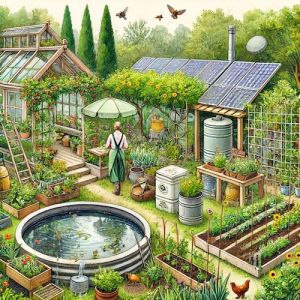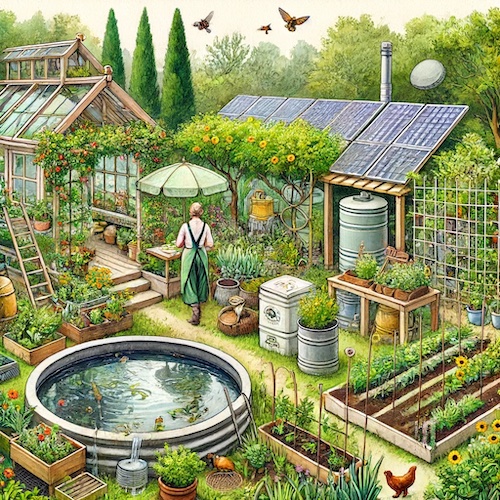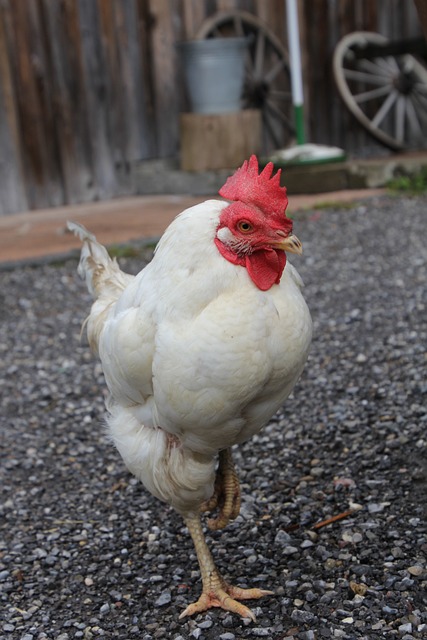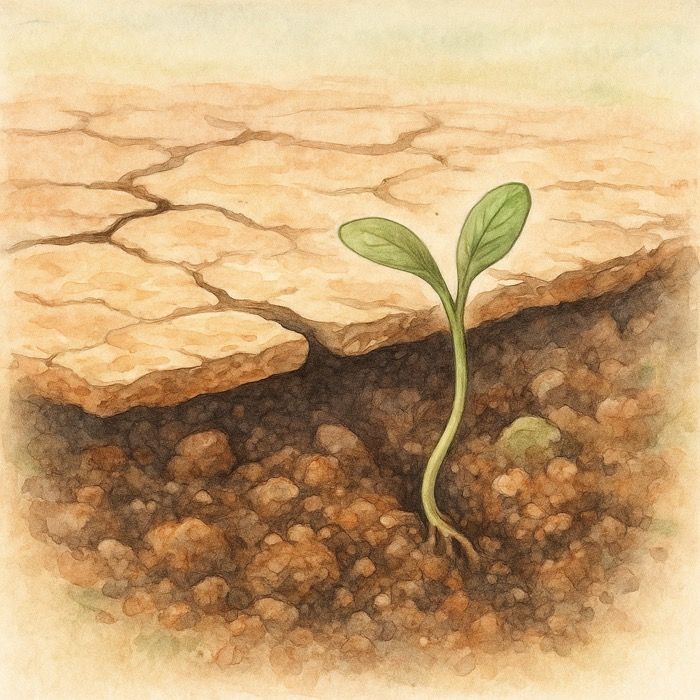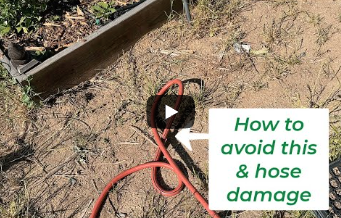Creating Your Own Permaculture Garden
A Sustainable Path to Bountiful Harvests
Introduction
Permaculture gardening is a revolutionary approach to sustainable living that integrates natural ecosystems and agricultural practices. By mimicking nature, permaculture gardens not only yield abundant crops but also conserve resources, enhance biodiversity, and improve soil health. In this guide, we will explore the principles of permaculture gardening and provide practical steps to create your own permaculture garden, transforming your outdoor space into a thriving, self-sustaining ecosystem.
Prefer Video? See our Wildly Popular Permaculture Series on Youtube
What is Permaculture Gardening?
Permaculture gardening is based on the principles of permaculture, a design philosophy that emphasizes working with nature rather than against it. The term “permaculture” combines “permanent” and “agriculture,” highlighting its focus on creating sustainable, long-term agricultural systems. Key principles of permaculture gardening include –
- Observe and Interact – Understand the natural patterns and processes in your environment.
- Catch and Store Energy – Harness renewable resources such as sunlight and rainwater.
- Obtain a Yield – Design your garden to produce food, fiber, and other resources.
- Apply Self-Regulation and Accept Feedback – Adapt and improve your gardening practices based on observations.
- Use and Value Renewable Resources and Services – Minimize waste and rely on renewable energy sources.
- Produce No Waste – Implement recycling and composting to close the nutrient loop.
- Design from Patterns to Details – Plan your garden layout based on natural patterns and refine the details as you go.
- Integrate Rather Than Segregate – Create mutually beneficial relationships between plants, animals, and insects.
- Use Small and Slow Solutions – Implement manageable, incremental changes.
- Use and Value Diversity – Enhance biodiversity to create a resilient garden ecosystem.
- Use Edges and Value the Marginal – Optimize the use of edges and transitional spaces.
- Creatively Use and Respond to Change – Embrace change and use it as an opportunity for innovation.
Steps to Create a Permaculture Garden
- Site Analysis and DesignBegin by observing your garden space. Note the sun’s path, wind patterns, soil type, and existing vegetation. Use this information to design a garden layout that maximizes sunlight, protects plants from harsh winds, and utilizes existing resources efficiently. Create zones based on proximity and use, with frequently accessed plants near your home and less frequently accessed areas further away.
- Soil Improvement– Healthy soil is the foundation of a successful permaculture garden. Improve soil fertility by adding organic matter such as compost, mulch, and cover crops. These materials enhance soil structure, retain moisture, and provide essential nutrients for plant growth.
- Water Management– Efficient water use is crucial in permaculture gardening. Implement rainwater harvesting systems, such as rain barrels or swales, to capture and store rainwater. Use mulch and ground covers to retain soil moisture and reduce evaporation. Design your garden to direct excess water towards plant roots and away from areas prone to erosion.
- Plant Selection and Placement– Choose a diverse range of plants that complement each other and fulfill different roles within the garden. Incorporate nitrogen-fixing plants, such as legumes, to enhance soil fertility. Plant flowers and herbs to attract pollinators and beneficial insects. Use companion planting to reduce pests and improve plant health. Consider perennial plants for long-term productivity and low maintenance.
- Mulching and Ground Cover– Mulching is a key practice in permaculture gardening. Apply a thick layer of organic mulch around plants to suppress weeds, retain soil moisture, and improve soil fertility. Ground covers, such as clover or creeping thyme, protect soil from erosion and provide additional habitat for beneficial insects.
- Integrating Animals– Animals play a vital role in permaculture systems. Chickens, ducks, and bees can provide eggs, meat, and honey, while also controlling pests and fertilizing the soil. Integrate animals thoughtfully to ensure their needs are met and their presence benefits the garden ecosystem.
- Composting and Waste Management– Implement a composting system to recycle kitchen scraps, garden waste, and other organic materials. Composting not only reduces waste but also creates nutrient-rich soil amendments that enhance plant growth. Consider vermicomposting (using worms) for efficient compost production.
- Continuous Learning and Adaptation– Permaculture gardening is an ongoing learning process. Regularly observe your garden, note changes, and adapt your practices accordingly. Join local permaculture groups, attend workshops, and read books on permaculture to expand your knowledge and stay inspired.
Master Gardener Segway – The Chicken
Examples are good, and In permaculture, chickens are an amazing example of the permaculture mindset, are often integrated into systems as part of a holistic approach to land management. Here are some examples of how chickens can be utilized in a permaculture system:
– Pest Control
Chickens are excellent at controlling pests such as insects, snails, and slugs. By allowing chickens to forage in garden areas, they can reduce pest populations naturally, minimizing the need for chemical pesticides.
– Soil Fertilization
Chicken manure is rich in nitrogen and other nutrients essential for soil health. In a permaculture system, chickens can be moved around in mobile coops (called “chicken tractors”) to spread their manure evenly across a landscape, enriching the soil and promoting plant growth.
– Weed Control
Chickens love to eat weeds and weed seeds. By allowing them to roam in specific areas, they can help control weed growth and reduce the seed bank in the soil.
– Composting Assistants
Chickens can be integrated into composting systems. They scratch and turn the compost pile, helping to aerate it and speed up the decomposition process, while also eating kitchen scraps and reducing waste.
– Orchard Maintenance
In orchards, chickens can help clean up fallen fruit, which can attract pests and diseases. Their scratching also helps to break up the soil surface, improving water infiltration and soil aeration.
These roles make chickens valuable contributors to a permaculture system, working in harmony with other elements to create a more sustainable and self-sufficient ecosystem.
Hopefully that example helps understand the permaculture ecosystem concept.,
Conclusion
Creating a permaculture garden is a rewarding journey towards sustainable living. By embracing the principles of permaculture, you can transform your garden into a thriving ecosystem that produces bountiful harvests while conserving resources and enhancing biodiversity. Start small, observe, learn, and gradually implement permaculture practices to create a resilient and productive garden that benefits both you and the environment.
For more gardening tips and sustainable living ideas, visit our Top rated gardening blog page and explore our collection of innovative and eco-friendly gardening products. Happy gardening!
FAQ for Permaculture Gardening
1. What is permaculture gardening?
Permaculture gardening is a sustainable approach to gardening that mimics natural ecosystems. It focuses on creating self-sustaining agricultural systems that conserve resources, enhance biodiversity, and improve soil health.
2. How does permaculture differ from traditional gardening?
Permaculture emphasizes working with nature rather than against it. Unlike traditional gardening, which often relies on chemical inputs and monocultures, permaculture uses natural processes, diverse plant species, and sustainable practices to create resilient and productive gardens.
3. What are the key principles of permaculture?
Some key principles of permaculture include:
- Observing and interacting with nature
- Catching and storing energy
- Obtaining a yield
- Applying self-regulation and accepting feedback
- Using and valuing renewable resources and services
- Producing no waste
- Designing from patterns to details
- Integrating rather than segregating
- Using small and slow solutions
- Valuing diversity
- Using edges and valuing the marginal
- Creatively using and responding to change
4. How do I start a permaculture garden?
To start a permaculture garden:
- Conduct a site analysis to understand your garden’s natural conditions.
- Design your garden layout based on natural patterns.
- Improve soil fertility with compost and organic matter.
- Implement water management strategies like rainwater harvesting.
- Select diverse plants that complement each other.
- Use mulch and ground covers to retain moisture and suppress weeds.
- Consider integrating animals for pest control and soil fertility.
- Regularly observe and adapt your practices.
5. What are some common plants used in permaculture gardens?
Common plants in permaculture gardens include:
- Nitrogen-fixing plants like legumes (beans, peas, clover)
- Perennial vegetables (asparagus, rhubarb)
- Fruit trees and berry bushes (apples, blueberries)
- Herbs (basil, rosemary, thyme)
- Companion plants (marigolds, nasturtiums)
6. How does permaculture help the environment?
Permaculture helps the environment by:
- Reducing the need for chemical fertilizers and pesticides
- Enhancing soil health and preventing erosion
- Conserving water through efficient management practices
- Increasing biodiversity and creating wildlife habitats
- Reducing waste through composting and recycling organic materials
7. Can I practice permaculture gardening in a small space?
Yes, permaculture principles can be applied in gardens of all sizes, from small urban plots to large rural areas. Techniques like vertical gardening, container gardening, and intensive planting can help you maximize productivity in small spaces.
8. What is companion planting in permaculture?
Companion planting is the practice of growing different plants together to benefit each other. This can include pest control, improved pollination, and enhanced growth. For example, planting marigolds with tomatoes can repel pests, while beans can fix nitrogen in the soil for other plants.
9. How do I manage pests in a permaculture garden?
Permaculture gardening uses natural pest control methods such as:
- Encouraging beneficial insects like ladybugs and bees
- Planting pest-repellent plants (e.g., marigolds, garlic)
- Using physical barriers like nets and row covers
- Maintaining plant diversity to disrupt pest cycles
- Introducing natural predators like chickens or ducks
10. What is the role of animals in permaculture gardens?
Animals play a vital role in permaculture gardens by:
- Providing manure to fertilize the soil
- Controlling pests by eating insects and weeds
- Producing food such as eggs, meat, and honey
- Enhancing biodiversity and creating balanced ecosystems
More info:
UC Davis has several resources and programs related to permaculture through its Agricultural Sustainability Institute and Sustainable Agriculture Research & Education Program (SAREP). Here are some highlights:
- Polycultures & Permaculture: UC Davis focuses on integrating polycultures and permaculture into sustainable agriculture systems. They emphasize the use of diverse plantings to improve soil health, reduce pests, and increase resilience to climate change. The institute hosts events and workshops on these topics, bringing together researchers and practitioners to design low-input, high-yielding systems that support biodiversity and ecosystem health.
- Ecological Garden at Student Farm: The Ecological Garden at UC Davis serves as a hands-on learning environment where students and community members can explore sustainable gardening practices, including composting, worm bins, and chicken care. It’s also home to the Flower Project, which cultivates flowers for use in bouquets, and the Kids in the Garden program, which provides garden-based learning for children.
- Sustainable Agriculture Resources: UC Davis provides a wide range of resources and publications on sustainable agriculture, including permaculture, organic farming, agroforestry, and climate resilience. They also offer internships, employment, and volunteer opportunities for students interested in sustainable agriculture.
For more information, you can explore the Sustainable Agriculture Research & Education Program at UC Davis and the Ecological Garden on their website.
More From Our Master Gardener
Special Christmas Gifts for Gardeners
Recent Posts

Top 20 Gardening Gifts for 2025: Best-Selling Picks from The Celtic Farm

The Hidden World of Soil Crusts – What They Are, Why They Kill Seedlings, and How to Fix or Prevent Them

Last-Minute Winter Garden Checklist: 5 Quick Tasks for Gardeners Who Are Behind (Like Me!)

❄️ Snow as Fertilizer – The Truth About “Poor Man’s Nitrogen”

5 Unexpected Winter Weed Control Strategies (That Don’t Involve Mulch)
